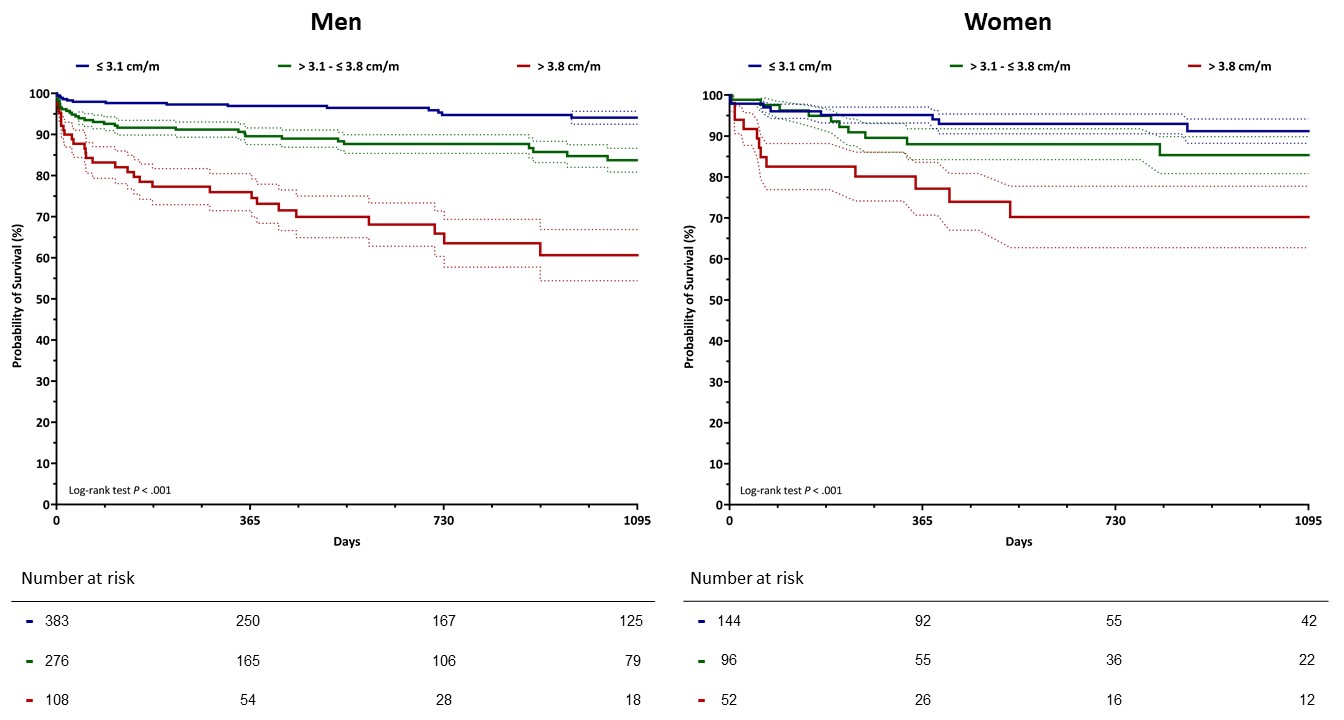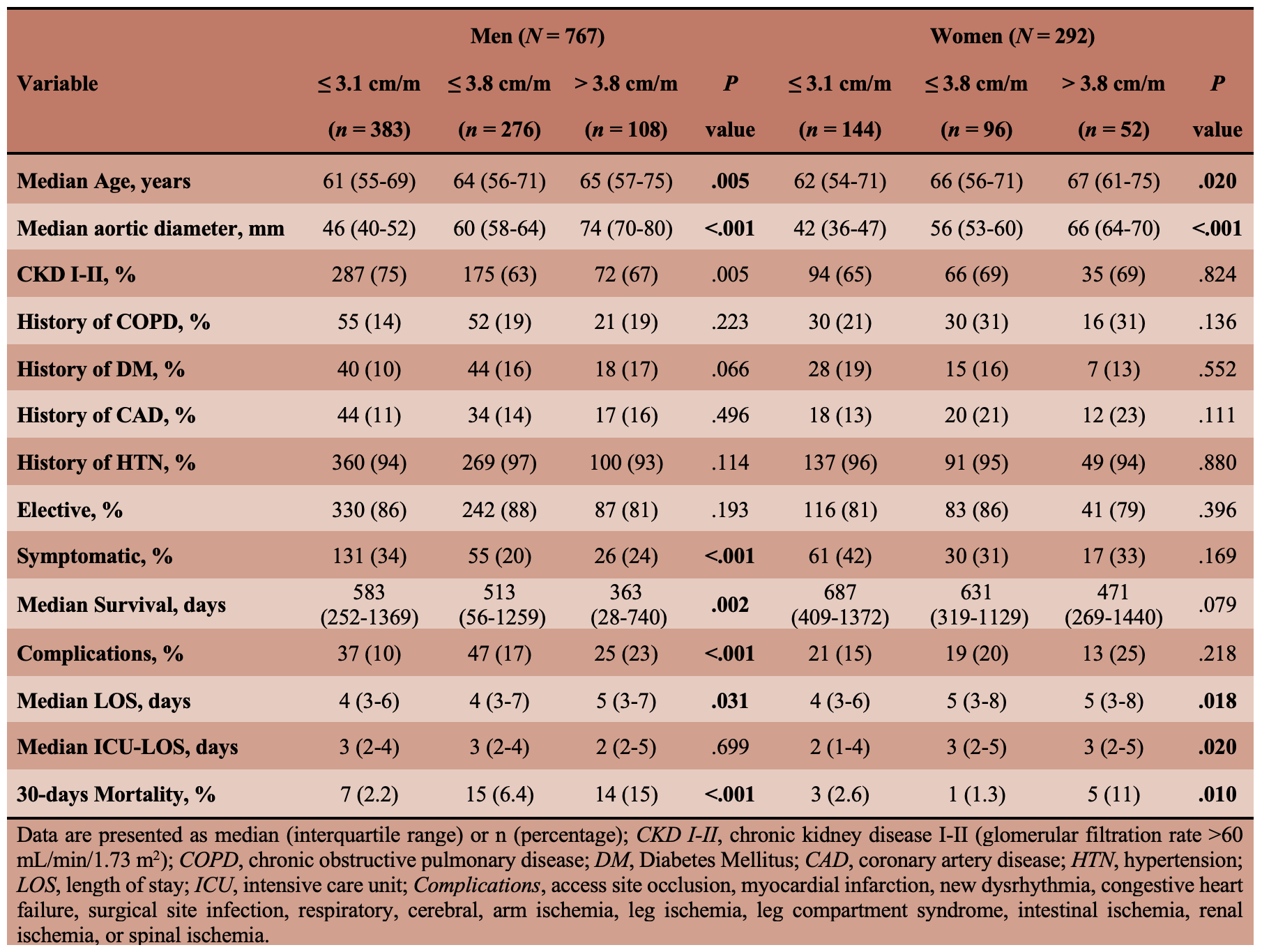Effects of Descending Thoracic Aortic Height Index on Midterm Survival After Thoracic Endovascular Aortic Repair in Patients with Chronic Type B Aortic Dissection
Alejandro Pizano, Jesus Porras-Colon, Carlos H. Timaran, Shirling Tsai, Melissa L. Kirkwood, J. Gregory Modrall, Bala Ramanan
University of Texas Southwestern Medical Center, Dallas, TX
INTRODUCTION: To evaluate the impact of the aortic height index (AHI) in men and women on mid-term survival after thoracic endovascular aortic repair (TEVAR) for chronic type B aortic dissection (cTBAD).
METHODS: Using the Vascular Quality Initiative database, patients who underwent TEVAR (repair zones 1-5) for cTBADs (>90-days after onset) between 2003-2020 were stratified by gender and AHI. Group-1 (≤3.1-cm/m), Group-2 (>3.1-≤3.8-cm/m), and Group-3 (≥3.8-cm/m). Those with connective tissue diseases were excluded. Cox proportional-hazard and survival models were used to estimate AHI impact after adjusting for potential confounders. ROC curve was used to determine the AHI cutoff for 3-year mortality.
RESULTS: There were 1059 patients with cTBAD; 72% were men, and the median (IQR) age was 63 (56-71) years. The AHI at the time of TEVAR in men and women was 3.1 (2.6-3.6) cm/m, and the aortic diameter was 55 (46-63) cm and 51 (42-60) cm, respectively. Table shows the main perioperative characteristics. The time between the onset of dissection and TEVAR was 386 (161-1288) days. Patients with AHI >3.8-cm/m had the worst survival in both men and women (Figure). In men, Group2 (HR, 2.76; 95% CI, 1.48-5.37; P=.002), Group-3 (HR, 8.48; 95% CI, 4.46-16.6; P<.001), aortic rupture (HR, 3.90; 95% CI, 1.15-12.7; P=.027), and emergent surgery (HR, 6.63; 95% CI, 2.16-19.4; P<.001) were associated with lower 3-year survival. In women, Group-3 (HR, 4.13; 95% CI, 1.52-11.6; P=.006) and COPD on oxygen (HR, 6.55; 95% CI, 0.88-30; P=.031) were associated with lower 3-year survival. The AHI index cuff-off point for repair appears to be >3.35-cm/m in men (Area, 0.74; HR, 4.29; 95% CI, 3.23-7.93; P<.001) and >3.45-cm/m in women (Area, 0.70; HR, 3.18; 95% CI, 1.64-6.18; P<.001). 34% of patients had aneurysms larger than these criteria.1-year survival associated with only disease-related mortality in men and women was 99.2±0.6, 97.8±1.1, 94.9±2.9; P=.032 and 97.9.2±1.6, 93.7±3.1, 90.0±5.5; P=.067, respectively.
CONCLUSIONS: There is a negative correlation between higher AHI and mid-term survival after TEVAR for cTBAD. Repair AHI cutoff associated with higher 3-year mortality in men and women was >3.35-cm/m and >3.45-cm/m, respectively, and 66% of patients had an AHI under these thresholds. Men with AHI >3.45-cm/m have significantly worse survival than other AHI groups. 

Back to 2023 Display Posters


